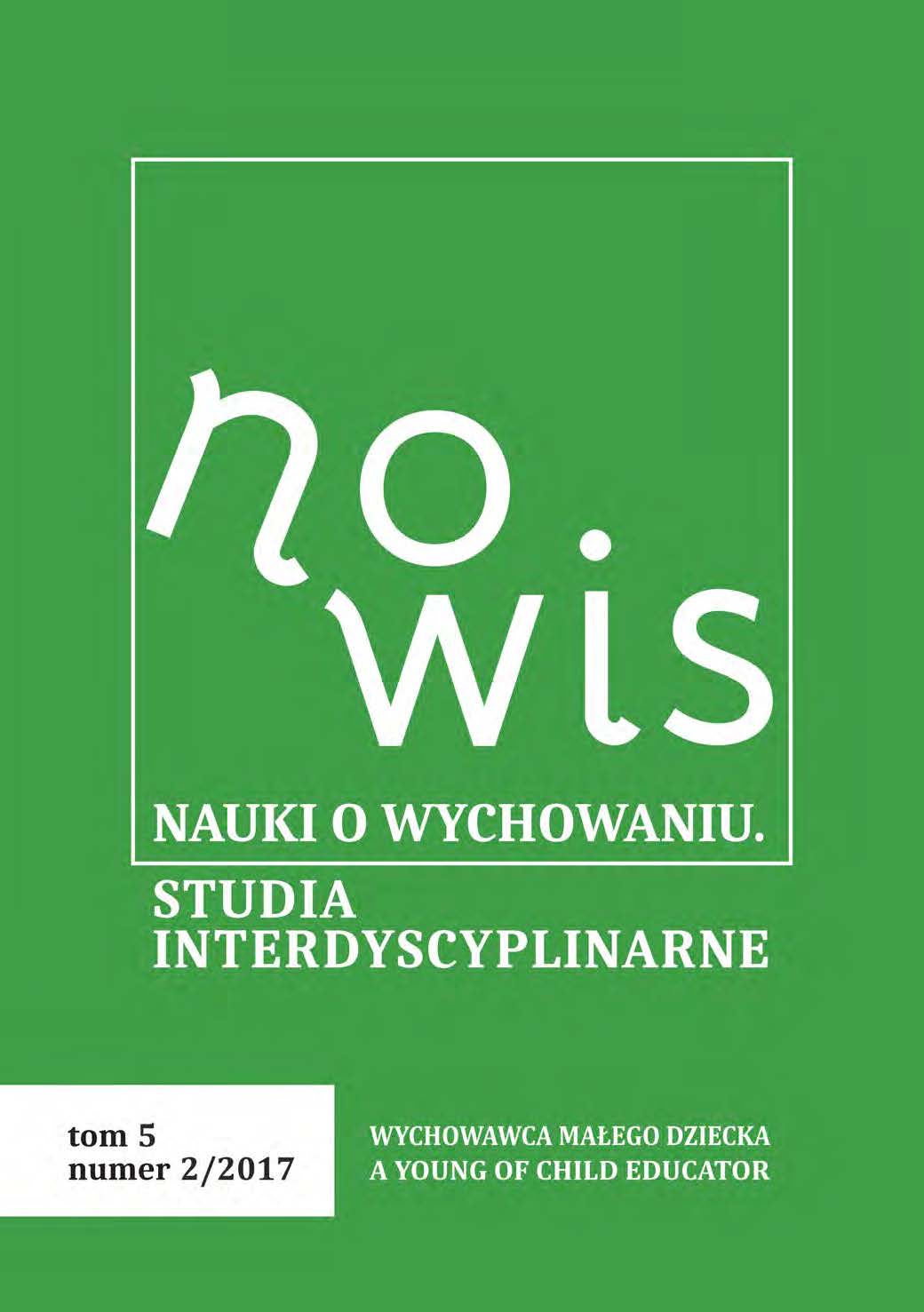QualityMatters: W jaki sposób i w jakich warunkach istotna jest jakość we wczesnej edukacji i opiece? Badanie w czterech krajach europejskich
DOI:
https://doi.org/10.18778/2450-4491.05.13Słowa kluczowe:
jakość systemu ECEC, interakcje nauczyciel-dziecko, przegląd międzynarodowyAbstrakt
QualityMatters to kontynuacja projektu CARE finansowanego przez Komisję Europejską. Celem projektu jest zbadanie, czy jakość interakcji między nauczycielem i dzieckiem jest różna w zależności od poszczególnych cech charakteryzujących klasę (np. rodzaje aktywności, treści i grup), aby znaleźć odpowiedź na nadrzędne pytanie: w jaki sposób i w jakich warunkach jakość w zakresie wczesnej edukacji i opieki ma znaczenie? Dzięki międzykulturowemu podejściu zorientowanemu na proces naukowcy zaangażowani w QualityMatters wykorzystają różnorodność systemów ECEC obecnych w 4 krajach europejskich (Finlandia, Holandia, Polska, Portugalia) w celu zbadania złożonych relacji, związanych z wyborami dokonywanymi przez nauczycieli w zakresie działalności i interakcji między nauczycielem a dzieckiem. W naszym projekcie przeanalizujemy zakres, w jakim interakcje dzieci w klasie z nauczycielami różnią się w zależności od warunków aktywności, biorąc pod uwagę specyfikacje krajowe dotyczące przepisów strukturalnych. Podczas gdy znaczna część badań dotyczących ECEC traktowała jakość strukturalną i procesową jako oddzielne konstrukty, QualityMatters przeanalizuje aspekty w miejscu krzyżowania się procesów i struktur, które prawdopodobnie okażą się istotne dla rozwoju dziecka i uczenia się.
Bibliografia
Barros S., Aguiar C. (2010) Assessing the quality of Portuguese child care programs for toddlers, “Early Childhood Research Quarterly”, 25: 527–535.
Google Scholar
Booren L. M., Downer J. T., Vitiello V. E. (2013) Observations of children’s interactions with teachers, peers, and tasks across preschool classroom activity settings, “Early Education and Development”, 23 (4): 517–538.
Google Scholar
Cadima J., Leal T., Burchinal M. (2010) The quality of teacher-student interactions: Associations with first graders’ academic and behavioral outcomes, “Journal of School Psychology”, 48: 457–482.
Google Scholar
Cryer D., Tietze W., Burchinal M., Leal T., Palacios J. (1999) Predicting process quality from structural quality in preschool programs: A cross-country comparison, “Early Childhood Research Quarterly”, 14: 339–361.
Google Scholar
Early D. M., Iruka I. U., Ritchie S., Barbarin O. A., Winn D. C., Crawford G. M., Pianta R. C. (2010) How do pre-kindergarteners spend their time? Gender, ethnicity, and income as predictors of experiences in pre-kindergarten classrooms, “Early Childhood Research Quarterly”, 25: 177–193.
Google Scholar
European Commission/EACEA/Eurydice/Eurostat (2014) Key Data on Early Childhood Education and Care in Europe, Eurydice and Eurostat Report, Luxembourg: Publications Office of the European Union.
Google Scholar
Fuligni A. S., Howes C., Huang Y., Hong S. S., Lara-Cinisomo S. (2012) Activity settings and daily routines in preschool classrooms: Diverse experiences in early learning settings for low-income children, “Early Childhood Research Quarterly”, 27: 198–209.
Google Scholar
Hamre B. K., Pianta R. C., Downer J. T., DeCoster J., Mashburn A. J., Jones S., Hamagami A. (2013) Teaching Through Interactions: Testing a developmental framework of teacher effectiveness in over 4,000 classrooms, “The Elementary School Journal”, 113: 461–487.
Google Scholar
Howes C., Guerra A. W., Fuligni A., Zucker E., Lee L., Obregon N. B., Spivak A. (2011) Classroom dimensions predict early peer interaction when children are diverse in ethnicity, race, and home language, “Early Childhood Research Quarterly”, 26: 399–408.
Google Scholar
La Paro K., Hamre B., Pianta R. (2012) Classroom assessment scoring system (CLASS) manual, toddler, Baltimore, MD, Paul H. Brookes.
Google Scholar
Lerkkanen M. K., Kiuru N., Pakarinen E., Viljaranta J., Poikkeus A. M., Rasku-Puttonen H., Siekkinen M., Nurmi J. E. (2012) The role of teaching practices in the development of children’s interest in reading and math in kindergarten, “Contemporary Educational Psychology”, 37 (4): 266–279.
Google Scholar
Leseman P. P. M. (2013) Quality of the early years provisions: an European perspective (working paper). Utrecht, the Netherlands, Utrecht University, Department of Special Education.
Google Scholar
Mashburn A. J., Pianta R. C., Hamre B. K., Downer J. T., Barbarin O. A., Bryant D., Howes C. (2008) Measures of classroom quality in prekindergarten and children’s development of academic, language, and social skills, “Child Development”, 79: 732–749.
Google Scholar
Melhuish E. C. (2004) Child Benefits: The importance of investing in quality childcare, London, Daycare Trust.
Google Scholar
Pessanha M., Aguiar C., Bairrao J. (2007) Influence of structural features on Portuguese toddler child care quality, “Early Childhood Research Quarterly”, 22: 204–214.
Google Scholar
Resa E., Ereky-Stevens K., Wieduwilt N., Penderi E., Anders Y., Petrogiannis K., Melhuish E. (2016) Overview of quality monitoring systems and results of moderator analysis. CARE Curriculum Quality Analysis and Impact Review of European ECEC, WP4, D4.3. Scientific report submitted to European Commission. Call Identifier: FP7-SSH-2013-2, Brussels, European Commission.
Google Scholar
Shonkoff J., Phillips D. (eds.) (2000) From Neurons to Neighborhoods: The Science of Early Childhood Development, Washington, DC, National Academy Press.
Google Scholar
Cabell S. Q., DeCoster J., LoCasale-Crouch J., Hamre B. K., Pianta R. C. (2013) Variation in the effectiveness of instructional interactions across preschool classroom settings and learning activities, “Early Childhood Research Quarterly”, 28(4): 820–830, doi:10.1016/j.ecresq.2013.07.007.
Google Scholar
Cadima J., Verschueren K., Leal T., Guedes C. (2016) Classroom interactions, dyadic teacher-child relationships, and self-regulation in socially disadvantaged young children, “Journal of Abnormal Child Psychology”, 44: 7–17, doi: 10.1007/s10802-015-0060-5.
Google Scholar
La Paro K. M., Williamson A. C. Hatfield B. (2014) Assessing quality in toddler classrooms using the CLASS-Toddler and the ITERS-R, “Early Education and Development”, 25 (6): 875–893, doi: 10.1080/10409289.2014.883586.
Google Scholar
Organization for Economic Co-operation & Development [OECD] (2006) OECD Starting Strong II early childhood education and care: Portugal, retrieved from http://www.oecd.org/education/school/37423722.pdf
Google Scholar
Phillips D. A., Fox N. A., Gunnar M. R. (2011) Same place, different experiences: Bringing individual differences to research in childcare, “Child Development Perspectives”, 5: 44–49, doi:10.1111/j.1750-8606.
Google Scholar
Slot P., Cadima J., Salminen J., Pastori G., Lerkkanen M.-K. (2016) Multiple case study in seven European countries regarding culture-sensitive classroom quality assessment. CARE Curriculum Quality Analysis and Impact Review of European ECEC, WP2, D2.3, Executive summary, retrieved from http://ecec-care.org/fileadmin/careproject/Publications/reports/summaries/D2_3_Multiple_Case_study_executive_summary.pdf
Google Scholar
Pobrania
Opublikowane
Jak cytować
Numer
Dział
Licencja

Utwór dostępny jest na licencji Creative Commons Uznanie autorstwa – Użycie niekomercyjne – Bez utworów zależnych 4.0 Międzynarodowe.





 Strona czasopisma, prowadzona przez Zespół redakcyjny NOWiS na platformie Index Copernicus:
Strona czasopisma, prowadzona przez Zespół redakcyjny NOWiS na platformie Index Copernicus: 





